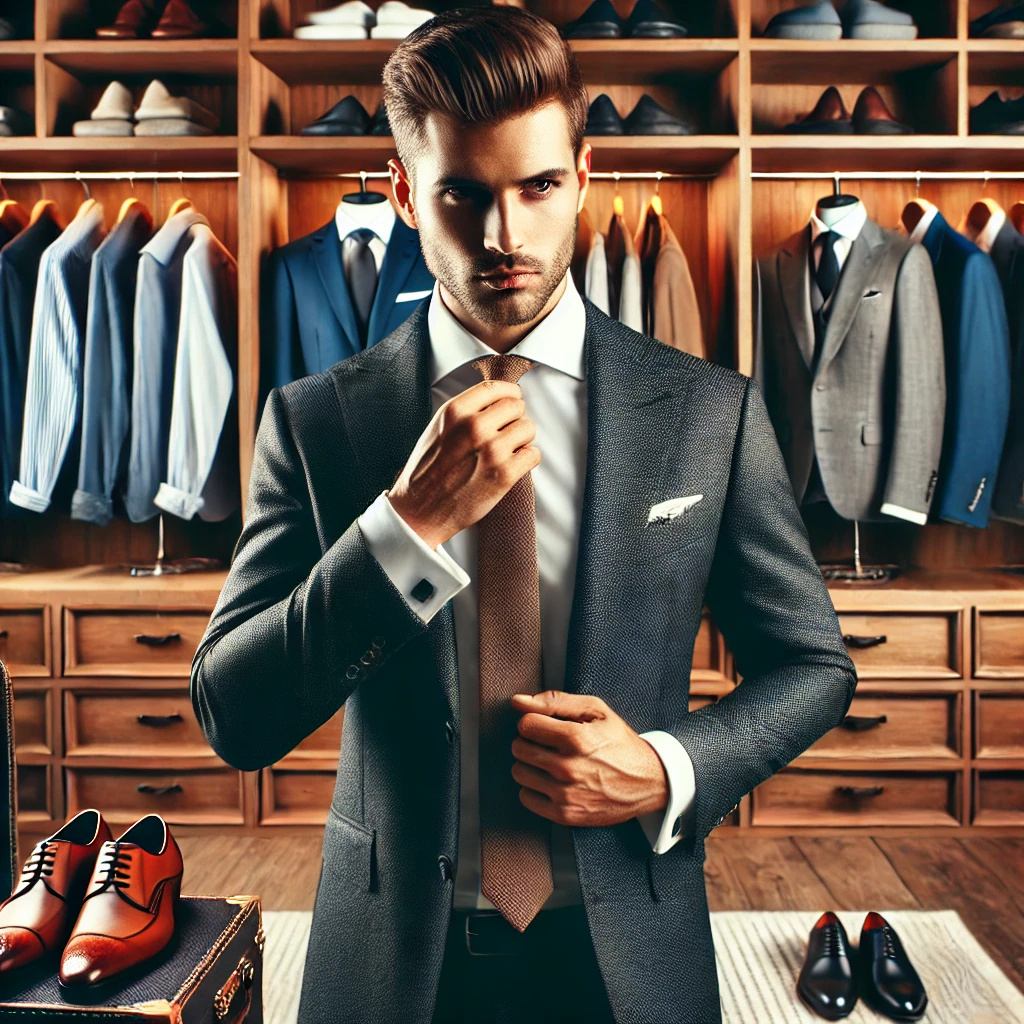Style is a reflection of personality, confidence, and self-expression. A well-dressed man not only looks good but also feels empowered in every setting, whether it’s a corporate meeting, a casual weekend outing, or a black-tie gala. Dressing appropriately for every occasion requires a keen understanding of fit, fabric, and fashion trends, but more importantly, it demands the ability to curate a wardrobe that balances versatility and sophistication.
This comprehensive guide will walk you through the fundamentals of men’s fashion, covering essential wardrobe staples, how to dress for different occasions, and styling tips that will elevate your overall appearance. From casual looks to business formal attire, you’ll learn how to make the best impression with your style.
1. The Fundamentals of Men’s Style 👔✨
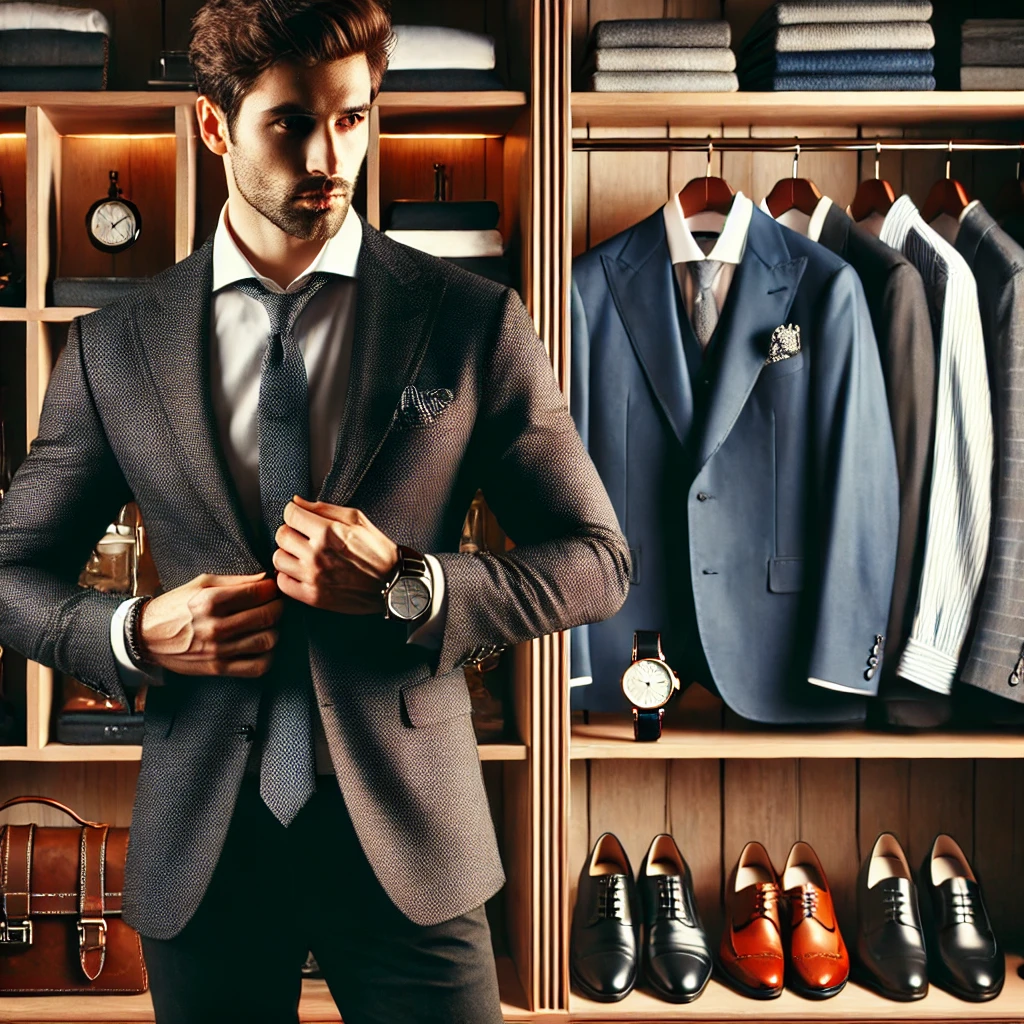
Before diving into specific occasions, it’s essential to understand the core principles of men’s fashion. These principles will serve as the foundation for creating a wardrobe that exudes style and confidence.
1.1 Fit is King
No matter how expensive or stylish an outfit is, if it doesn’t fit well, it won’t look good. A well-fitted outfit enhances your physique and provides a polished appearance.
- Shirts – The shoulder seam should align perfectly with your shoulder, and the sleeves should end at the wrist bone.
- Pants – The waistband should sit comfortably without needing a belt, and the length should have minimal break.
- Jackets & Blazers – The jacket should hug your shoulders and allow movement without excessive looseness.
1.2 Color Coordination 🎨
Understanding color theory helps in mixing and matching outfits effortlessly.
- Neutral Colors (black, white, gray, navy, beige) – Versatile and timeless, making them ideal for foundational wardrobe pieces.
- Bold Colors (red, green, mustard, burgundy) – Add personality but should be used strategically.
- Complementary Colors – Pairing opposite colors on the color wheel (e.g., navy and mustard) creates visually appealing contrasts.
1.3 Fabric & Texture Matters 🧵
Different fabrics serve different purposes and seasons:
- Cotton – Breathable and ideal for casual and smart-casual wear.
- Linen – Perfect for warm weather but wrinkles easily.
- Wool – Best for suits, offering durability and structure.
- Denim – A staple fabric for casualwear that never goes out of style.
1.4 Building a Timeless Wardrobe 🏆
Investing in classic and versatile pieces ensures longevity and adaptability in your wardrobe.
- White Oxford Shirt – A must-have for both formal and casual outfits.
- Dark Denim Jeans – Pairs well with blazers or t-shirts.
- Tailored Navy Suit – The ultimate power suit for formal occasions.
- Brown & Black Leather Shoes – Covers most formal and semi-formal settings.
2. Dressing for Every Occasion 🎭👞

Each occasion demands a different level of formality and style. Below is a breakdown of how to dress appropriately for various events without sacrificing individuality.
2.1 Casual Wear: Effortless Everyday Style
Casual dressing doesn’t mean sloppy—it’s about looking relaxed yet put-together.
- Tops: Well-fitted t-shirts, polo shirts, Henley shirts, casual button-downs.
- Bottoms: Chinos, dark denim, tailored joggers.
- Footwear: Sneakers, loafers, casual boots.
- Accessories: Minimalist watches, sunglasses, caps.
Style Tips:
- Opt for layering (e.g., a denim jacket over a t-shirt) for a structured look.
- Choose monochrome outfits for a sleek and modern appearance.
- Well-fitted joggers paired with a structured hoodie can create an athleisure look.
2.2 Smart Casual: The Perfect Balance
Smart casual is a blend of sophistication and relaxation, ideal for business lunches or date nights.
- Tops: Button-down shirts, turtlenecks, fitted sweaters.
- Bottoms: Slim-fit chinos, dark denim jeans.
- Footwear: Chelsea boots, loafers, dress sneakers.
- Accessories: Leather belts, subtle jewelry, stylish sunglasses.
Style Tips:
- Roll up your sleeves slightly for a relaxed but sharp look.
- A blazer over a fitted turtleneck instantly upgrades the outfit.
- Avoid flashy logos—opt for clean, minimal designs.
2.3 Business Casual: Office-Ready Looks
The business casual dress code allows for professionalism without the formality of a suit.
- Tops: Oxford shirts, well-fitted polos, tailored sweaters.
- Bottoms: Dress pants, tailored chinos.
- Footwear: Leather loafers, brogues, derbies.
- Accessories: Classic wristwatch, leather belt.
Style Tips:
- A knit blazer can replace a structured blazer for a more comfortable yet refined appearance.
- Stick to neutral tones (gray, navy, beige) for an elegant look.
- Avoid sneakers—opt for dress shoes or sleek loafers.
2.4 Business Formal: Power Dressing
For corporate meetings, job interviews, and formal work environments, a well-tailored suit is essential.
- Tops: Crisp white or light blue dress shirts.
- Suits: Navy, charcoal, or black.
- Footwear: Oxfords, monk straps, polished leather shoes.
- Accessories: Silk tie, tie clip, pocket square, quality watch.
Style Tips:
- Always ensure suit sleeves show about ¼ inch of the shirt cuff.
- Your belt and shoes should match for a cohesive look.
- A well-fitted suit can be the difference between looking good and looking great.
2.5 Black-Tie & Formal Events
Black-tie occasions demand absolute elegance and sophistication.
- Outfit: A tailored tuxedo or a formal black suit.
- Shirt: White dress shirt with French cuffs.
- Footwear: Polished black Oxford shoes.
- Accessories: Black bow tie, cufflinks, pocket square.
Style Tips:
- A velvet or silk lapel adds a touch of uniqueness.
- Ensure your shirt is always well-pressed for a crisp, clean look.
- Avoid wearing a belt with a tuxedo—opt for suspenders instead.
3. Seasonal Fashion: Dressing Smart Throughout the Year 🌦️❄️☀️🍂
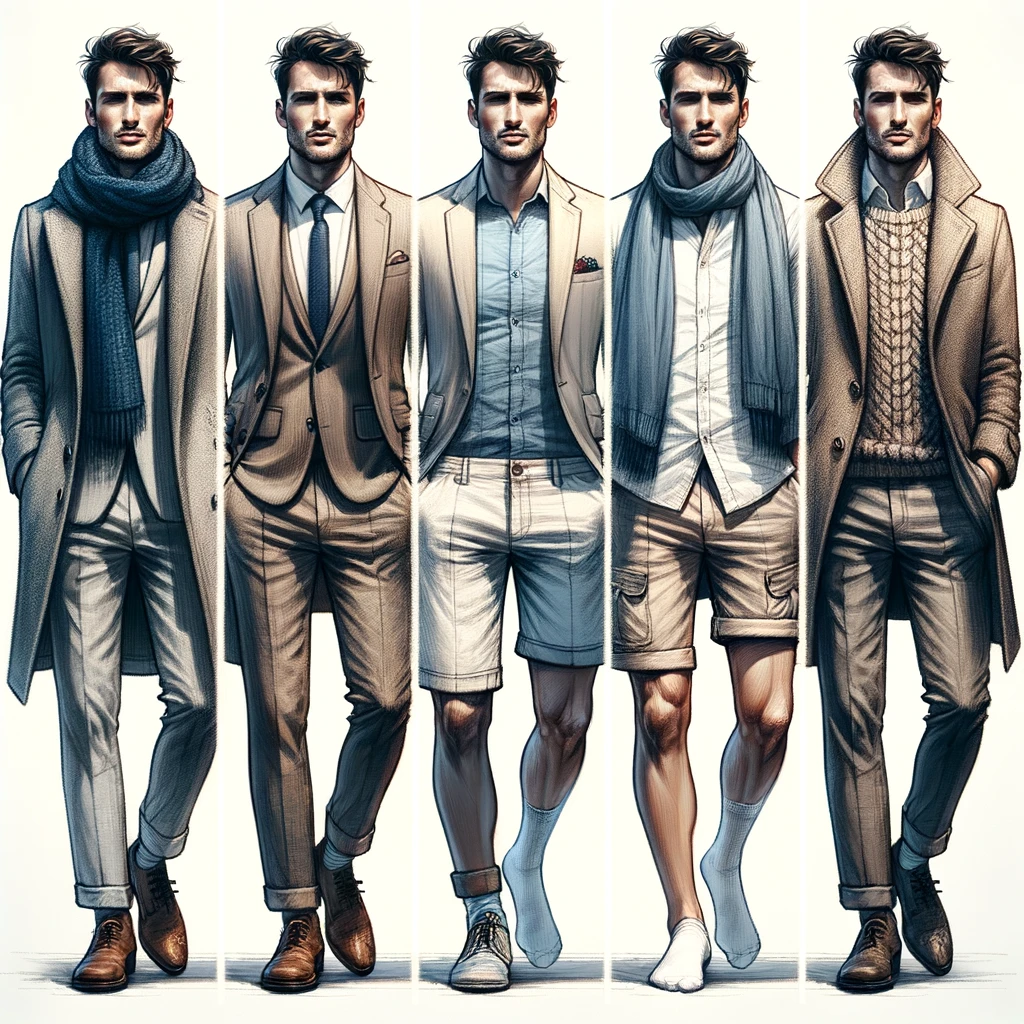
Dressing well isn’t just about understanding different styles; it’s also about adapting your wardrobe to the changing seasons. The way you dress should not only reflect your personal style but also keep you comfortable, functional, and stylish throughout the year. Each season brings unique fashion opportunities and challenges, and understanding how to curate a wardrobe that transitions seamlessly across different weather conditions is essential.
3.1 Spring Style: Fresh, Light, and Layered
Spring is the season of renewal, and your wardrobe should reflect that by incorporating light fabrics, fresh colors, and adaptable layering.
- Fabrics: Stick to lightweight materials like cotton, linen, and light wool blends that allow your skin to breathe while keeping you comfortable in fluctuating temperatures.
- Colors: Soft pastels, light neutrals, and vibrant blues work well in spring. Think light blue blazers, mint green shirts, and off-white chinos.
- Outfits:
- Casual: A fitted polo shirt with tailored chinos and white sneakers.
- Smart Casual: A lightweight blazer over a button-down shirt, paired with slim-fit jeans and loafers.
- Business Casual: A light wool or linen suit in beige or navy, paired with a crisp white shirt.
Spring Style Tip: Layer smartly with unstructured blazers, light sweaters, and stylish trench coats. This allows you to stay warm during chilly mornings while being able to adjust your outfit as temperatures rise throughout the day.
3.2 Summer Style: Keeping Cool While Looking Sharp
Summer dressing is all about staying cool while maintaining elegance. The key is to embrace breathable fabrics and opt for lightweight, loose-fitting clothing that allows airflow while still looking sharp.
- Fabrics: Linen, seersucker, chambray, and lightweight cotton are your best friends.
- Colors: Opt for light tones like white, sky blue, beige, and light gray, which reflect sunlight rather than absorb it.
- Outfits:
- Casual: A linen short-sleeved button-down with chino shorts and espadrilles.
- Smart Casual: A lightweight cotton blazer over a crisp t-shirt, paired with tailored trousers and loafers.
- Formal: A summer suit in beige or light gray with a breathable cotton shirt and loafers.
Summer Style Tip: Ditch heavy socks and embrace no-show socks or sockless styles with loafers or espadrilles for a clean summer look.
3.3 Fall Style: Mastering the Art of Layering
Fall is one of the most stylish seasons, offering opportunities to experiment with textures, layering, and earthy tones. The fluctuating temperatures require strategic layering that adds depth and functionality to your outfits.
- Fabrics: Wool, flannel, tweed, and denim work best for fall outfits.
- Colors: Earthy tones such as olive green, rust, deep burgundy, and mustard yellow enhance autumn’s aesthetic.
- Outfits:
- Casual: A fitted crewneck sweater over a chambray shirt, paired with dark jeans and Chelsea boots.
- Smart Casual: A wool blazer over a turtleneck with chinos and brogues.
- Business: A three-piece tweed suit with a textured tie and classic dress shoes.
Fall Style Tip: Invest in a versatile trench coat or wool overcoat, which pairs well with both casual and formal looks.
3.4 Winter Style: Staying Warm Without Sacrificing Elegance
Winter fashion is about balancing warmth with sophistication. This is the season for structured layering, classic overcoats, and heavy-duty fabrics that provide insulation without compromising style.
- Fabrics: Wool, cashmere, leather, and heavyweight cotton keep you warm.
- Colors: Darker shades like charcoal, navy, black, and deep brown create a refined winter look.
- Outfits:
- Casual: A thick wool sweater over a flannel shirt with dark denim and sturdy boots.
- Smart Casual: A wool peacoat over a turtleneck, paired with wool trousers and leather Chelsea boots.
- Formal: A structured wool or cashmere overcoat over a tailored suit with leather gloves.
Winter Style Tip: Layering should be functional, not bulky. Use base layers, mid-layers, and stylish outerwear to create a structured, polished look.
4. Essential Accessories: Elevating Your Look ⌚🕶️
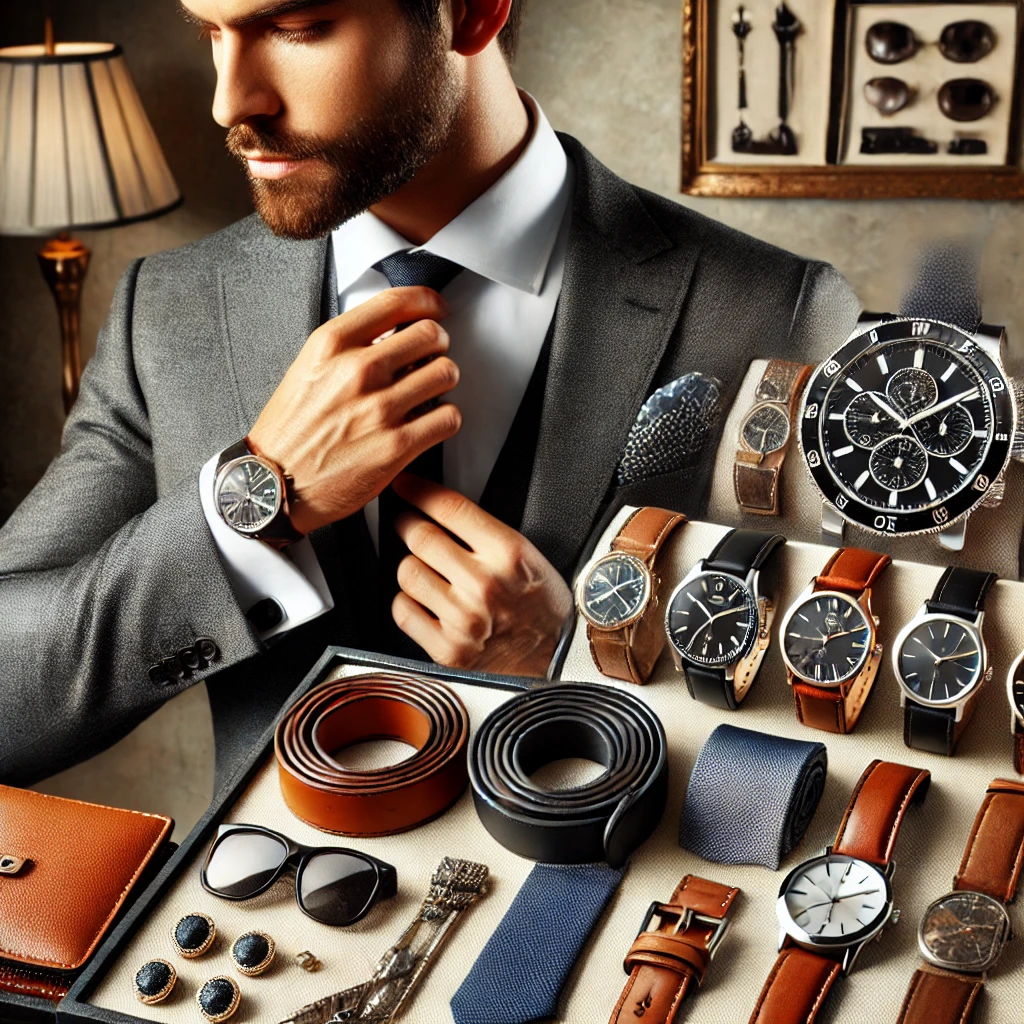
Accessories are the finishing touches that take an outfit from good to exceptional. A well-chosen accessory not only enhances your look but also reflects personality and attention to detail.
4.1 Watches: The Ultimate Statement Piece
A quality wristwatch is one of the most defining accessories a man can own. Whether you prefer a classic leather strap, a stainless steel bracelet, or a modern smartwatch, your watch should complement your outfit.
- Dress Watch: Slim and sophisticated, perfect for formal settings.
- Diver’s Watch: A rugged, versatile option that pairs well with both casual and smart casual looks.
- Chronograph Watch: Stylish and functional, ideal for business casual settings.
4.2 Eyewear: Sunglasses & Prescription Glasses
Your eyewear should not only enhance vision but also contribute to your overall aesthetic. Choose frame styles that complement your face shape and outfit.
4.3 Belts, Ties & Pocket Squares
- Belts should match your shoes in color and style.
- Ties should complement, not overpower, your outfit.
- Pocket squares add a touch of elegance and allow for personal expression.
5. Grooming & Hygiene: The Foundation of Style 💈🪒
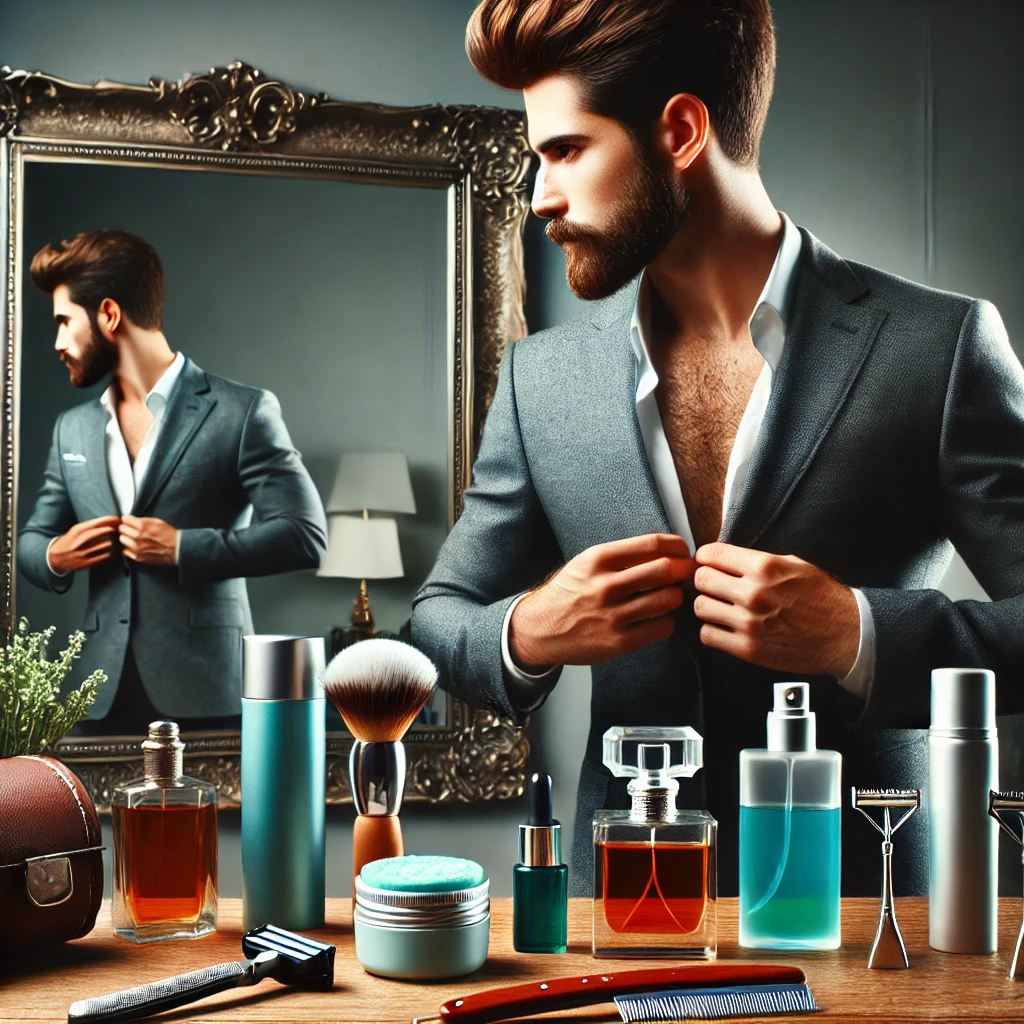
Your style is incomplete without proper grooming and hygiene. No matter how expensive or well-fitted your outfit is, poor grooming habits can undermine your entire appearance. A polished and refined look extends beyond clothing—it requires meticulous self-care, including hair maintenance, skincare, facial grooming, and fragrance selection. In this section, we will explore the essentials of male grooming and hygiene to help you always look sharp and feel confident.
5.1 Haircare & Beard Grooming
A well-groomed hairstyle or beard enhances your look and boosts your confidence. Grooming is about maintaining cleanliness, shaping your hair to complement your face, and choosing the right products that suit your hair type.
Haircuts & Maintenance
- Get a haircut every 3-4 weeks to maintain a fresh and neat appearance.
- Choose a hairstyle that complements your face shape—whether it’s a short fade, a slicked-back look, or a textured cut.
- Use high-quality shampoos and conditioners that match your hair type (e.g., hydrating formulas for dry hair, volumizing shampoos for thin hair).
- Avoid excessive heat styling and harsh hair products that cause dryness or damage.
Beard Grooming & Shaving Routine
- If you grow a beard, keep it well-trimmed and shaped according to your facial structure.
- Use beard oils and balms to keep facial hair soft and manageable.
- Shave regularly with a high-quality razor, and always apply aftershave to prevent irritation.
- Clean your beard with a beard-specific shampoo to avoid dryness and dandruff.
- Keep your neckline well-groomed—unkempt neck hair gives a messy appearance.
5.2 Skincare Routine: Achieve a Healthy, Glowing Look
Healthy skin is a key component of a polished appearance. A proper skincare routine ensures clear, smooth, and youthful-looking skin. Following a daily skincare regimen tailored to your skin type will prevent acne, dullness, and premature aging.
Basic Skincare Routine for Men
- Cleansing: Wash your face twice daily with a gentle facial cleanser to remove dirt and oil buildup.
- Exfoliation: Use an exfoliating scrub 2-3 times a week to get rid of dead skin cells and promote a smoother complexion.
- Moisturizing: Apply a lightweight moisturizer daily to keep your skin hydrated and prevent dryness.
- Sun Protection: Always wear SPF 30+ sunscreen to prevent premature aging and skin damage from UV rays.
- Eye Cream: If you experience dark circles or puffiness, use an eye cream to keep your under-eye area fresh and youthful.
Skincare Tip: Your diet and hydration also affect your skin. Drink plenty of water, eat a balanced diet rich in vitamins, and avoid excessive sugar and alcohol to maintain a healthy complexion.
5.3 Fragrance & Cologne: The Power of Scent
A great fragrance is a silent yet powerful confidence booster. Your choice of cologne creates a memorable impression and adds a personal touch to your style. A refined scent not only completes your look but also conveys personality and sophistication.
How to Choose the Right Fragrance
Fragrances are categorized into different scent families, and each suits specific occasions and personality types:
- Fresh & Citrusy: Ideal for daytime and summer events (e.g., lemon, bergamot, grapefruit).
- Woody & Earthy: Great for business meetings and winter settings (e.g., sandalwood, cedar, musk).
- Spicy & Oriental: Perfect for evening wear, formal events, and romantic dates (e.g., cinnamon, vanilla, tobacco).
- Aquatic & Clean: Suitable for casual and sporty settings (e.g., sea salt, marine notes).
How to Apply Cologne Correctly
- Apply to pulse points—wrists, neck, behind the ears—for long-lasting scent distribution.
- Do not rub your wrists together after applying cologne; this breaks down the fragrance molecules.
- Use sparingly—2 to 3 spritzes are enough to make an impact without being overpowering.
- Reapply if needed, but do not overdo it—subtlety is key.
5.4 Oral Hygiene & Personal Care
A well-groomed man also prioritizes oral hygiene and general cleanliness. Fresh breath, clean nails, and overall hygiene habits are non-negotiable aspects of a stylish gentleman.
- Brush your teeth twice a day and floss daily for a bright smile.
- Use mouthwash to eliminate bacteria and keep your breath fresh.
- Trim your nails weekly and ensure they are clean and well-maintained.
- Use antiperspirant or deodorant daily to prevent body odor.
- Shower regularly and choose mildly scented body washes that complement your cologne.
5.5 Hand and Foot Care: Attention to the Details
Many men overlook hand and foot care, yet these are key aspects of overall grooming. Having well-maintained hands and feet signals attention to detail, hygiene, and self-care.
Hand Care for a Polished Look
- Trim your nails once a week, ensuring they are even and clean.
- Use a moisturizing hand cream daily to prevent dryness and cracks.
- If you work with your hands often, consider using cuticle oil to prevent roughness.
- Exfoliate your hands once a week to remove dead skin and maintain softness.
Foot Care for Year-Round Confidence
- Trim your toenails properly—cut straight across to prevent ingrown nails.
- Use a foot scrub or pumice stone to keep your heels smooth and prevent calluses.
- Moisturize your feet to avoid dryness and cracked skin.
- If you wear sockless shoes, use foot powders or sprays to prevent odor and moisture buildup.
Hand & Foot Care Tip: If your nails become weak or brittle, consider a professional manicure and pedicure. Clean, well-groomed hands and feet leave a lasting impression.
5.6 Posture & Body Language: The Unspoken Style Statement
Your posture and body language play a crucial role in how people perceive your confidence, presence, and elegance. Even the most well-dressed man can lose impact if his body language suggests insecurity or discomfort.
How to Improve Your Posture for a More Commanding Presence
- Stand tall with your shoulders back—this exudes confidence and strength.
- Avoid slouching when sitting or walking, as it gives an unrefined appearance.
- When sitting, keep your back straight and shoulders relaxed to maintain an elegant demeanor.
- Engage your core muscles while standing or walking to naturally improve posture.
- Make eye contact when speaking to others—it conveys attentiveness and assurance.
Body Language Tips for a Stylish & Confident Demeanor
- A firm handshake conveys professionalism and self-assurance.
- Avoid crossing your arms, as it can make you seem closed off.
- Use deliberate hand gestures while speaking to enhance your communication.
- Walk with purpose—taking confident, steady strides improves your overall image.
- When wearing a suit, place one hand in your pocket casually rather than both hands, to avoid looking overly rigid.
Posture & Body Language Tip: Practicing good posture not only enhances your style but also boosts self-confidence, energy levels, and even mood. A confident stance makes every outfit look better!
Conclusion
Looking sharp isn’t just about what you wear—it’s about how you present yourself as a whole. Grooming and hygiene are just as important as well-fitted suits, stylish shoes, and accessories. A well-maintained haircut, skincare routine, and signature fragrance elevate your entire presence and set you apart from the rest.
By following these grooming principles, you will develop a timeless, polished, and confident look that enhances your personal style. Remember, a well-groomed man exudes sophistication, professionalism, and charm in every setting!
